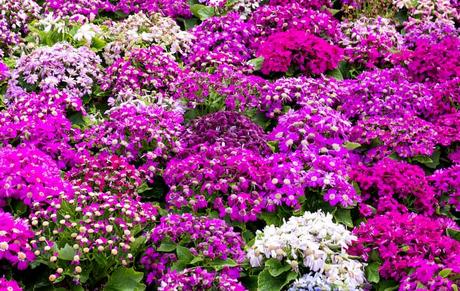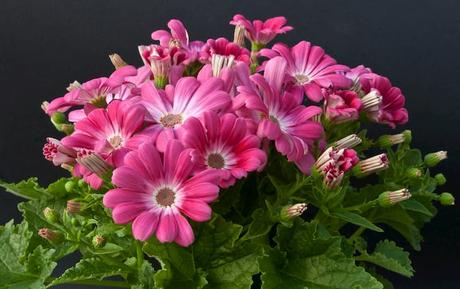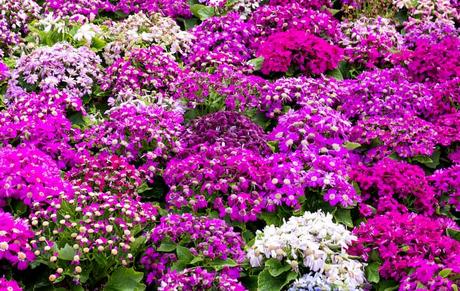Ultimate Guide to Grow and Care Cineraria Plant: Growing Information and Tips
If you are planning to grow and care for Cineraria plants, you’re not the only one. For the uninitiated, Cineraria plants are beautiful and tender perennial plants that produce pretty flowers. The unique aspect of these plants is the fact that its flowers often have striking similarities with that of the daisy.
Native to the Canary Islands, the Cineraria plants originally feature greyish green foliage. Since this gray element was deemed undesirable several hybrids of the Cineraria were created and most of them have lush green leaves.

The Cineraria plant varies greatly depending on the size. While you’ll find some of them in dwarf varieties, others can reach a lofty height of up to five feet.
These plants are usually short-lived and since they can’t resist frost, most owners discard them after the flowers start fading. Either way, Cinerarias are extremely easy to care for and when kept the right way, they’ll turn out to be one of the best house plants.
In this article, we will discuss these plants in detail shedding light on watering guidelines, sunlight requirements, soil requirements, and more.
How to Grow and Care For Cineraria Plant?
Watering
Cineraria plants require plenty of water and they thrive best in soil that is both well-drained and moist. However, it is important to note here that moist doesn’t necessarily translate to soggy.
Avoid overwatering the plant until it reaches a point where the soil is completely waterlogged as this might lead to the plant’s death whereby its roots will rot. Since rotten roots cannot tap in any moisture, avoid overwatering at all points.
One of the easiest ways to check the moistness of the soil is by checking the soil condition before proceeding to water it. You do this in a simple step. Just dip one or two fingers in the soil and check if it is dry or moist. In the case of the latter, avoid watering the plant for at least a day and check back again. In case the soil dries out over the next few hours, water it immediately.
Although the Cineraria plant cannot thrive in waterlogged conditions, it cannot thrive in super-dry conditions either. Unlike other plants that can withstand a bout of drought, Cineraria plants will dry out pretty soon. That is why it is important to exercise proper care to ensure that the soil doesn’t dry out when you water it in between.
Sunlight
If you are keeping the Cineraria plant outdoors, consider keeping it in a spot where it receives either partial or complete shade. While flowering plants usually do not prefer shade, the Cineraria plant is different as it requires plenty of shade.
Use this trait of the plant to your advantage by keeping in a darker part of the garden. This spot too will be perfectly brightened with the vibrant blooms of the plant.
Note that while the plant prefers shade, it can withstand some degree of sunlight. However, this is ideally during the mornings when the rays of the sun aren’t as intense. During the afternoons, you can bring it back to a partially or completely shaded area as this is highly appropriate for the plant.
In case you’re keeping this plant as your houseplant, make sure it receives bright light, indirectly. This is an ideal position. The Cineraria plant doesn’t require massive amounts of light to thrive in your room. However, it is more likely to struggle to survive in shades if you keep it as a houseplant. So, if you are planning to get this plant, the best option would be to keep it outdoors.
Soil

Buy From Amazon
As with most other flowering plants, Cineraria plants will require a properly balanced soil environment. In addition to the pH balance you also need to check if the soil is well-drained.
Rich soil that comes with plenty of organic matter like compost works best for these plants because these kinds of soil drain quite well while also retaining a significant amount of moisture. Since the moisture is held around the plant’s roots, they tend to thrive much better.
Remember, when it comes to Cineraria plants, soil type is of utmost importance. This alone will determine whether the plant is getting its watering requirements fulfilled. Heavy soil that drains poorly will end up adding excessive moisture to the plant’s root which in turn will cause it to rot.
Likewise, gritty soil that tends to drain fast won’t provide enough time for the roots to soak up the excess water. While the plant prefers relatively acidic soil, they can thrive well in almost all well-drained and fertile soil.
Temperature
Cineraria plants are quite hardy, and they can survive in the US-based hardiness zones of 9 to 11. While they prefer a fairly cool temperature, these plants aren’t frost hardy. Flowers are grown annually in the hardiness zones, and if the soil, temperature, and water conditions are accurate, they can bloom throughout the year.
If you are planting the Cineraria outside the mentioned zones, they will turn out to be short-lived perennial plants. Here too, the plants are likely to die sooner when the frost finally arrives. They also cannot survive amid temperature dips, especially during the night times.
These plants will almost immediately die if the temperature falls below 35 degrees F during the nights. In the daytime, the ideal temperature ranges between 55 degrees to 65 degrees F. When kept at this temperature level, these plants will bloom for an extensive period. They will stop blooming after the temperature crosses 80 degrees F.
If you are planning to keep these plants as your houseplant, make sure they are kept at an average temperature. In some instances, you can also shift them to a cooler room as excessive warmth is likely to affect the quality of the flowers. Avoid keeping the plant near a cold draft or a heating vent.
Humidity
The Cineraria plants thrive best in areas with high humidity. While it isn’t always possible to control the humidity in the outdoors, you can always try your bit by keeping the soil moist. This will elevate the humidity level as air along the plant will achieve a certain moistness while the moisture continues to evaporate.
If you are planning to keep these plants indoors, you will require extra measures for increasing the humidity level. Since the air inside our homes is often dry, it is important to exercise proper measures to ensure that the plant thrives well. One of the easiest ways to regulate humidity indoors is by misting the plant with water once in a while. However, do not overdo this as it might affect the quality of the flowers. If you are not comfortable with the idea of misting, get an electric humidifier and a pebble tray.
You can also make your only pebble tray at home by spreading a layer of pebbles or gravels and then sitting the pot of the plant right over it. Make sure the pebbles get plenty of water. As the water starts evaporating, the humidity along the plant is likely to increase. Consistently top the water for maintaining a proper level of humidity,
If you are using pebble trays, make sure the level of water doesn’t reach the base part of the pot as it can easily get trapped up through the excess drainage holes causing the soil to be soggy and leading to instances of overwatering. Some gardeners also recommend allowing the water level of the trays to reach the base of the plant pots as it helps to maintain a perfectly moist ball of the root. Since this is the primary requirement of Cineraria plants it is highly recommended.
Flowers

The flowers of Cineraria plants bear much resemblance to the common daisy. They stand in lofty clusters on elongated stems with their massive foliage. If the Cineraria plant is larger the bloom is likely to measure 5 inches or more. They can, however, be slightly smaller when it comes to dwarf species. In mild climates, they can bloom throughout the entire year. However, in cool parts, they only bloom in the summer months.
Flowering Period
The blooming period of the Cineraria plant ranges between February and April. They bloom in plenty of vibrant colors. Upon achieving complete bloom, the flowers look like single or double form daisies. Following is a detailed insight into the flowering period of these plants:
June to August: The seeds of the Cineraria plants are doing just fine. They will require consistent light to germinate at this stage. Avoid covering the seeds with any excess or loose soil. Instead, lightly press the seeds into the soil.
You need to water the soil properly before sowing the seeds inside it. Do not water it after already sowing the seeds. In terms of temperature, the ideal temperature would be 67 degrees F. Seedlings will gradually appear at this point within two weeks.
When you spot the first seedling, reduce the temperature to 60 degrees F. Always remember that unlike their mature counterparts, Cineraria plants cannot withstand direct sunlight at the germination stage. In terms of soil, you can use your preferred blend of sand peat.
September to January: After potting the plantlet of the seedling, continue preserving it in a completely cool environment. The plant is likely to thrive better when kept in greenhouses. This is also because these plants aren’t very fond of the rain.
While potting the plant, make sure the soil is completely moist. You should also feed it with liquid plant food at least once every seven days. Keep the temperature at 48 degrees F at this stage. The area too needs to be airy and free from every kind of draft.
February to April: When the weather is finally clear, the plant will start budding. When you spot the budding raise the temperature level to around 60 degrees F or more. The plant will need around four weeks for achieving full bloom. Once the flowering finally ends, its cycle will begin again.
Flower Colors
Multiple varieties of these plants have developed throughout the year and you can now get them in almost all colors. Top options include red, blue, magenta, violet, pink, and purple.
Guidelines for Buying Cineraria Plants
If you are planning to buy an already potted Cineraria plant always check the leaves. Make sure they are both juicy and lush. Besides, you should also check if the plant already has flowers.
Since more flowers are deemed better in this regard, it is highly recommended to check the number of flowers before making the purchase. In addition to flowers, the next thing you should look out for is the buds. Make sure the plant has plenty of buds as it will be more manageable in this case.
Well, now that you know everything about the Cineraria plant, what are you waiting for? Get these pretty little houseplants right away to deck up your balcony or patio just the way you want to!
References:
Sunlight requirements for Cineraria plants


